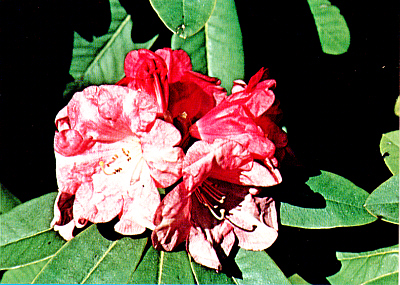Rhododendron fortunei rubra R. S. F. 73.115
P. H. Brydon, Salem, Oregon

|
|
R. fortunei rubra
Photo by P. H. Brydon |
In the 1948 R. H. S. Rhododendron Year Book, N. K. Gould and Patrick M. Synge, describing rhododendrons at Towercourt, wrote as follows "the red flowered
R. fortunei
which had only recently flowered for the first time and which is perhaps sufficiently distinct to merit description as a new species". Propagations from this plant flowered in the Rhododendron Species Foundation garden at Salem from May 15th to June 1st, 1972, and our records show that the plant came from Dr. Carl Phetteplace in Eugene. When I asked him about the source of his plant, he said that he had admired the plant when visiting Towercourt and Mrs. Stevenson had kindly sent him cuttings. During this same visit he met Mr. Davidian walking in Mrs. Stevenson's garden and, seeking more information from the well known authority, he was told that, in all probability, it was a new species.
There are many plants called
R. fortunei
in cultivation today, most of which are hybrid seedlings or, perhaps, related species in the Fortunei Series. Indeed, the plant which we refer to as
R. fortunei rubra
(for want of a better name) may be a natural hybrid since it arose from a batch of seed collected in the wild and flowered at Towercourt. Upon checking our plant against the description of
R. fortunei
in "The Species of Rhododendron", the characters seem to agree within reasonable limits. However, in our plant, and in contrast to
R. fortunei
, the 6-9 flowered inflorescence is not pendulous and the calyx, while gland fringed, is up to 1 cm. long. Furthermore, the corolla is ruby red in bud, becoming deep rose when open and eventually fading to pale rose. The varying stages of color from bud to open flower presents quite a charming overall effect.
In our severe winter of 1972-73 (with temperatures to 10 below zero) the plant proved to be bud hardy and survived with a minimum of leaf scorch. Our plant is now seven feet tall and has an open shrubby habit. The potential of this species (or hybrid) is promising, particularly if one is seeking a parent to produce a large flowered red.